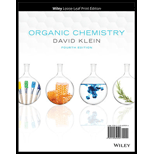
Concept explainers
(a)
Interpretation:
Major and minor products must be predicted for the given reaction.
Concept Introduction :
SN2 reaction competes with E2 and SN1 reaction competes with E1.
(b)
Interpretation:
Structures of major and minor products must be predicted for the given reactions.
Concept Introduction :
SN2 competes with E2 and SN1 competes with E1. NaOH is more nucleophilic than basic.
(c)
Interpretation:
Major and minor products must be predicted for the given reactions.
Concept Introduction :
SN2 reaction competes with E2.
(d)
Interpretation:
Major and minor products must be shown for the given reaction.
Concept Introduction :
DBU is a non-nucleophilic base.
(e)
Interpretation:
Major and minor product must be predicted for the given reaction.
Concept Introduction :
Tert-butoxide is a strong bulky base which prefers elimination.
(f)
Interpretation:
Major and minor products must be predicted from the given reaction.
Concept Introduction :
A primary substrate with less crowding prefers substitution over elimination.
Want to see the full answer?
Check out a sample textbook solution
Chapter 7 Solutions
ORGANIC CHEMISTRY-PRINT (LL)-W/WILEY
- Would the following organic synthesis occur in one step? Add any missing products, required catalysts, inorganic reagents, and other important conditions. Please include a detailed explanation and drawings showing how the reaction may occur in one step.arrow_forward(a) Sketch the 'H NMR of the following chemical including the approximate chemical shifts, the multiplicity (splitting) of all signals and the integration (b) How many signals would you expect in the 13C NMR? CH3arrow_forwardDraw the Show the major and minor product(s) for the following reaction mechanisms for both reactions and show all resonance structures for any Explain why the major product is favoured? intermediates H-Brarrow_forward
- 3. Draw ALL THE POSSBILE PRODUCTS AND THE MECHANISMS WITH ALL RESONANCE STRUCTURES. Explain using the resonance structures why the major product(s) are formed over the minor product(s). H₂SO4, HONO CHarrow_forward7. Provide the product(s), starting material(s) and/or condition(s) required for the No mechanisms required. below reaction HO + H-I CI FO Br2, FeBr3 O I-Oarrow_forward6. Design the most efficient synthesis of the following product starting from phenot Provide the reaction conditions for each step (more than one step is required) and explain the selectivity of each reaction. NO MECHANISMS ARE REQUIRED. OH step(s) CIarrow_forward
- What is the skeletal structure of the product of the following organic reaction?arrow_forwardIf a reaction occurs, what would be the major products? Please include a detailed explanation as well as a drawing showing how the reaction occurs and what the final product is.arrow_forwardWhat is the major organic product of the following nucleophilic acyl substitution reaction of an acid chloride below?arrow_forward
 Organic Chemistry: A Guided InquiryChemistryISBN:9780618974122Author:Andrei StraumanisPublisher:Cengage Learning
Organic Chemistry: A Guided InquiryChemistryISBN:9780618974122Author:Andrei StraumanisPublisher:Cengage Learning
 Organic ChemistryChemistryISBN:9781305580350Author:William H. Brown, Brent L. Iverson, Eric Anslyn, Christopher S. FootePublisher:Cengage Learning
Organic ChemistryChemistryISBN:9781305580350Author:William H. Brown, Brent L. Iverson, Eric Anslyn, Christopher S. FootePublisher:Cengage Learning



